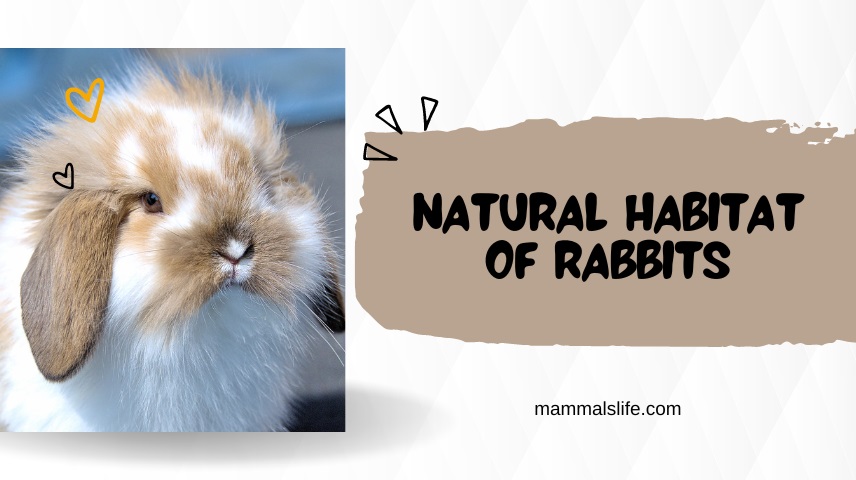Last Updated on February 22, 2025 by Mammals Life
Rabbits naturally inhabit meadows, forests, grasslands, and wetlands. They thrive in environments offering abundant food and shelter.
Rabbits are highly adaptable creatures found across various continents, including North America, Europe, and Asia. They prefer areas with dense vegetation to hide from predators and access to ample food sources like grasses and leafy weeds. These habitats provide the necessary conditions for rabbits to burrow and create their complex underground warrens.
Burrows offers protection from extreme weather and predators, ensuring their survival. Rabbits’ ability to reproduce quickly and adapt to different environments has allowed them to thrive in diverse habitats worldwide. Understanding their natural habitat helps in conserving their populations and managing their impact on ecosystems.
Forest Habitats
Rabbits are fascinating creatures that thrive in various habitats. One of their primary homes is the forest. Forest habitats provide the perfect environment for rabbits to live and thrive.
Types Of Forests
Rabbits can be found in different types of forests. Each forest type offers unique conditions that support rabbit life. Let’s explore the main types:
| Forest Type | Forest Type |
|---|---|
| Deciduous Forests | These forests have trees that shed their leaves annually. They offer plenty of shelter and food for rabbits. |
| Coniferous Forests | These forests consist of evergreen trees. They provide good cover and food sources like berries and herbs. |
| Mixed Forests | These forests contain both deciduous and coniferous trees. They offer a diverse habitat with ample food and shelter options. |
Rabbits’ Adaptations
Rabbits have several adaptations that help them thrive in forest habitats. These adaptations include:
- Camouflage: Their fur color often matches the forest floor, making them less visible to predators.
- Burrowing: Rabbits dig burrows to hide from predators and extreme weather.
- Keen Senses: They have excellent hearing and a wide field of vision to detect danger.
- Diet: Rabbits can eat a variety of plants, ensuring they always find food.
Rabbits’ adaptability to different forest types ensures their survival. Understanding these habitats helps us appreciate the resilience of these creatures.
Grasslands And Meadows
Grasslands and Meadows are among the most favored habitats for rabbits. These open areas provide an ideal mix of food sources and hiding spots. The lush grasses and diverse plant life support their dietary needs and offer ample cover from predators.
Diet And Foraging
In grasslands and meadows, rabbits find a variety of foods. Their diet includes:
- Grasses
- Herbs
- Leaves
- Flowers
- Bark
Rabbits are skilled foragers. They nibble on tender shoots and leaves. They prefer young, succulent plants. This diet provides them with the nutrients they need to stay healthy.
Predator Awareness
Rabbits in grasslands and meadows must always be alert. They are prey for many animals, such as:
| Predator | Type |
|---|---|
| Foxes | Mammals |
| Hawks | Birds |
| Snakes | Reptiles |
To survive, rabbits use their keen senses. They rely on their strong sense of smell and hearing. They often freeze to avoid detection. When threatened, they flee to their burrows for safety.
Desert Environments
Rabbits are known to adapt to various habitats. One surprising environment is the desert. Deserts are harsh and dry, yet some rabbits thrive here. These rabbits have unique traits to survive the extreme conditions.
Survival Tactics
Rabbits in deserts have special survival tactics. They dig deep burrows to escape the heat. These burrows are cool and protect them from predators. Rabbits are also mostly active during dawn and dusk. This helps them avoid the hottest part of the day.
Their fur color blends with the sandy environment. This makes it harder for predators to spot them. Rabbits also have long ears to help cool their bodies. The ears release heat, keeping them cooler.
Resource Scarcity
Deserts have limited food and water. Resource scarcity is a big challenge. Rabbits eat tough plants that other animals avoid. These plants include cacti, shrubs, and dry grasses. Rabbits get moisture from the plants they eat.
Water is rare in deserts. Rabbits drink dew that forms on plants. They also get water from the food they eat. Rabbits have a special way to conserve water. They produce dry feces to save as much water as possible.
Here’s a quick summary of their survival traits:
- Deep burrows for cool shelter
- Active during cooler parts of the day
- Camouflaged fur
- Long ears to release heat
- Eating tough, water-rich plants
- Drinking dew
- Producing dry feces
These traits help rabbits survive in one of the harshest environments on Earth.
Urban And Suburban Areas
Rabbits are adapting to urban and suburban areas. They find food and shelter easily. Gardens and parks attract them. These areas offer safety from predators.
Human Interaction
Rabbits in urban areas often interact with humans. Some people feed them. Others may build shelters. This can help rabbits survive. But, it can also make them dependent on humans.
Safety Concerns
Living in cities poses dangers for rabbits. Roads and cars are a big threat. Pets like dogs and cats can harm them. Urban areas also have less green space. This makes it harder for rabbits to hide.
| Benefits | Challenges |
|---|---|
| Easy access to food | Risk of getting hit by cars |
| Availability of shelter | Threat from pets |
| Less predators | Limited green space |
Wetlands And Marshes
Rabbits are adaptable creatures that thrive in various environments. One such habitat is wetlands and marshes. These areas provide essential resources and shelter for rabbits. Let’s explore how rabbits live and thrive in these unique environments.
Water Sources
Wetlands and marshes are rich in water sources. Rabbits rely on these for hydration and food. The abundance of freshwater ensures they stay healthy. Wetlands often have streams, ponds, and small lakes. Rabbits drink from these water bodies. They also find aquatic plants and insects to eat.
Shelter Options
Rabbits need safe places to hide and rest. Wetlands and marshes offer a variety of shelter options. Dense vegetation, such as reeds and tall grasses, provide excellent cover. Rabbits use these plants to build nests and burrows. They also hide from predators in the thick foliage.
Here is a table summarizing their shelter options:
| Shelter Type | Description |
|---|---|
| Dense Vegetation | Reeds, tall grasses, and shrubs |
| Nests | Made from plants and leaves |
| Burrows | Underground tunnels for safety |
Rabbits also benefit from the natural camouflage provided by wetland plants. The colors and textures help them blend in. This reduces their risk of being seen by predators. Rabbits in wetlands are well-protected and have ample resources to thrive.
Frequently Asked Questions
What Is The Rabbit’s Natural Habitat?
Rabbits naturally inhabit meadows, forests, grasslands, and wetlands. They prefer areas with dense cover to hide from predators.
What Is The Best Habitat For A Rabbit?
The best habitat for a rabbit includes a spacious, safe enclosure with plenty of hay, fresh vegetables, and water. Ensure they have hiding spots and toys for mental stimulation. Regular outdoor time in a secure area is beneficial.
How Do Rabbits Thrive?
Rabbits thrive with a balanced diet, clean water, safe shelter, and regular exercise. Social interaction and mental stimulation also help.
What Is A Rabbit’s Preferred Habitat?
Rabbits prefer habitats with dense vegetation. They thrive in meadows, forests, grasslands, and wetlands. They seek areas with ample food and cover to hide from predators.
Where Do Rabbits Live In The Wild?
Rabbits live in meadows, forests, grasslands, and wetlands.
What Is A Rabbit’s Natural Habitat?
A rabbit’s natural habitat includes burrows, bushes, and dense vegetation.
Conclusion
Rabbits thrive best in environments that offer ample vegetation and shelter. Understanding their natural habitat helps in conservation efforts. By protecting these areas, we ensure rabbits continue to flourish. Whether in forests, meadows, or grasslands, rabbits need safe, natural spaces.
Let’s work together to preserve their habitats for future generations.








